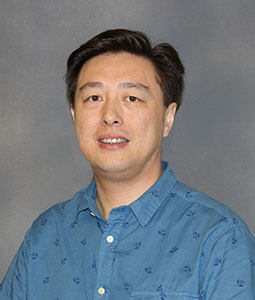Department of Chemistry and Biochemistry
Faculty and Staff Directory
Hui Wang
| Title: | Professor / Physical and Theoretical Biochemistry and Molecular Biology / Biophysical / Materials / Nano / Spectroscopy |
| Department: | Chemistry and Biochemistry McCausland College of Arts and Sciences |
| Email: | wang344@mailbox.sc.edu |
| Phone: | 803-777-2203 |
| Fax: | 803-777-9521 |
| Office: | Office: GSRC 221 Lab: GSRC 219, 803-777-0523 Lab 2: GSRC 427, 803-576-5693 |
| Resources: |
CV [pdf] |

Education
B. S., 2001, Nanjing University
Ph. D., 2007, Rice University
Honors and Awards
USC Breakthrough Star Award, 2014
NSF CAREER Award, 2013
Research Interests
Research Areas: Nanoscience; Surface-enhanced spectroscopy; Biophysics; Bioanalytical chemistry.
The central theme of our research is to use physical chemistry approaches, specifically spectroscopy and electrochemistry, to tackle challenging problems in materials and biological sciences.
Nanostructures with Geometrically Tunable Optical Properties. Nanophotonic materials have emerged as an important class of subwavelength optical components that interact with light in unique ways on the nanometer length-scale. Our interests in nanophotonic materials broadly span several important aspects in this field, including but not limited to nanostructure fabrication, nanoscale self-assembly, structure-property relationship, and applications of these materials. We have been working on several nanostructures with geometrically tunable optical properties, such as semiconductor nanoshells, metal-semiconductor core-shell hetero-nanostructures, and complex metallic nanoparticles. We are particularly interested in (i) development of new approaches for the controllable fabrication of optically active nanostructures; (ii) utilization of optically active nanostructures as building blocks to assemble mesoscopic structures over multiple length scales; (iii) detailed characterization of the optical properties of these nanomaterials both at the ensemble and single-nanoparticle levels; (iv) development of quantitative understanding on the structure-property relationship of these nanostructures through combined experimental and theoretical efforts; and (v) applications of these nanophotonic materials in surface-enhanced spectroscopies for ultrasensitive molecular sensing.
Multifunctional Nanoprobes for Electrochemical Cytosensing. The past two decades have witnessed significant progress on the development of robust analytical tools with high sensitivity, selectivity, and reproducibility toward early diagnosis of cancer. Electrochemical cytosensing has emerged as an extremely attractive method that can be readily implemented into quantitative bioassays for high-throughput clinical applications. Utilization of rationally designed multifunctional nanoprobes and specifically tailored nano-biointerfaces for electrochemical cytosensing provides unique opportunities to optimize the interfacial electron transfer and cell recognition processes, allowing for the integration of large signal amplification, enhanced detection specificity, and expanded multiplex sensing capabilities on one cytosensor. Our group has been working on the design and fabrication of multifunctional hybrid nanoprobes for selective and ultrasensitive electrochemical detection of a variety of cancer cells, such as leukemia cells and circulating tumor cells. Our electrochemical approaches also allow for the quantification of the expression levels of important biomarkers on the cancer cell surfaces.
Single-Molecule Biophysics. Our group has been working on the development of detailed, molecular-level understanding of important nucleic acid (NA) structural remodeling processes chaperoned by retroviral nucleocapsid (NC) proteins. In spite of their structural simplicity, retroviral NC proteins exhibit a diverse set of biological functions that are crucial to the retroviral life-cycles. The role of NC proteins as NA chaperones is perhaps their most important function ever known so far. NC proteins promote several NA structural remodeling processes that are crucial to the retroviral life-cycles, such as the obligatory strand transfers in the reverse transcription, the maintenance and integration of proviral DNA, and the genomic RNA protection and packaging. NC-chaperoned NA structural remodeling typically involves various intermediates along multiple reaction pathways and is tightly associated with heterogeneous conformational dynamics over multiple time-scales that cannot be synchronized and resolved by ensemble measurements. Single-molecule spectroscopy provides an extremely powerful way to characterize such complex biomolecular processes without the ensemble averaging effects. Our group uses time-resolved single-molecule spectroscopy as an analytical tool to study the kinetics and mechanism of NC-chaperoned NA annealing that occurs during the reverse transcription and to resolve the conformational dynamics associated with NC-induced local bending of proviral DNA. These single-molecule measurements allow us to gain molecular-level insights on the complicated, dynamic NC-NA interactions that underpin NCs' NA chaperone functions.
Publications
Sun, L.; Zhang, Q.; Li, G.G.; Villarreal, E.; Fu, X.; Wang, H.*, Multifaceted Gold-Palladium Bimetallic Nanorods and Their Geometric, Compositional,
and Catalytic Tunabilities. ACS Nano 2017, 11 (3), 3213−3228.
DOI: 10.1021/acsnano.7b00264.
Li, G. G.; Lin, Y.; Wang, H.*, Residual Silver Remarkably Enhances Electrocatalytic Activity and Durability of Dealloyed Gold Nanosponge Particles. Nano Letters 2016, 16 (11), 7248−7253. DOI: 10.1021/acs.nanolett.6b03685.
Zhang, Q. F.; Han L. L.; Jing, H.; Blom, D. A.; Lin, Y.; Xin, H. L; Wang, H.*, Facet Control of Gold Nanorods. ACS Nano 2016, 10, 2960-2974,
DOI: 10.1021/acsnano.6b00258.
Zhang, Q. F.; Zhou, Y. D.; Villarreal, E.; Lin, Y.; Zou, S. L.; Wang, H.*, Faceted Gold Nanorods: Nanocuboids, Convex Nanocuboids, and Concave Nanocuboids. Nano Letters 2015, 15 (6), 4161 - 4169. DOI: 10.1021/acs.nanolett.5b01286.
Zheng, T. T.; Zhang, Q. F.; Feng, S.; Zhu, J. J.; Wang, Q.; Wang, H.*, Robust Nonenzymatic Hybrid Nanoelectrocatalysts for Signal Amplification toward Ultrasensitive Electrochemical Cytosensing. Journal of The American Chemical Society, 2014, 136 (6), 2288 - 2291. DOI: 10.1021/ja500169y.